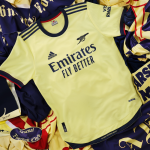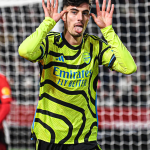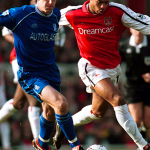
Arsenal will continue to use the old crest in the next season
The cannon will be retained on the Gunners' second jersey, following one of the strongest trends of recent years

April 15th, 2022
The fashion of vintage logos, which has become one of the major trends of contemporary football aesthetics fishing in the deep sea of nostalgia, it's not stopping soon. This is confirmed by the choice of Arsenal, which after taking the scepter of the coolest team in England with the help of adidas, next season will use again the old crest with the Woolwich cannon without the shield, as happened from the 60s to the late 80s, on the second kit. A historical logo that over time has settled in the hearts of London fans, and that would please many, from the longest fans to collectors who could add a new piece to their long line of red and white shirts.
The history of Arsenal's crest is long and winding, starting way back in 1886 and going through a series of changes, even and especially in the guns, which have always defined the club's aesthetic. After dealing with different formats and styles, from gothic to naturalistic, in 2002 the company decided to make a change by defining once and for all the Gunners' logo, cleaning it up and simplifying it for possible commercial uses since it had not managed to record all the elements of the previous one. The logo with the cannon pointing east and embedded in the red shield edged with blue and gold was immediately associated with Arsene Wenger's Invincibles, one of the cult teams in Premier League history, and no one ever really thought of changing it.
At least until adidas replaced PUMA as kit supplier, opening the London club's trunk of memories and pulling out the old cannon logo. For now only on the second shirts, following the trend that is dominating lately on the shirts of European teams, where they are recovered old logos dear to the fans to differentiate more and more the various game kits, perhaps associating them with special events. For example, as was done by New Balance and Roma during the derby against Lazio, in which the Giallorossi took to the field with the fourth jersey and the ASR emblem, or as requested in vain by the fans of Atletico Madrid before the return match of the Champions League quarter-finals against Manchester City, who would have preferred to see the old logo on the jersey.
But not only them, in recent seasons also clubs such as Liverpool, Ajax, Inter, Atalanta have made jerseys recovering coats of arms belonging to past eras, in an attempt to reconnect with a part of their tradition that could remain diluted in the various restyling. Recently we have written about how changing the crest of the teams risks to change irremediably even soccer itself, but at the same time this use of various logos during the same season risks to create confusion and to be just a way to multiply the revenues of the club itself. In fact, more than celebrating the tradition and heritage of a team, this multiplication of visual identities leads to a fragmentation of the sporting soul, suspended between the decision to keep up with the times and monetizing on the memories of the fans.












